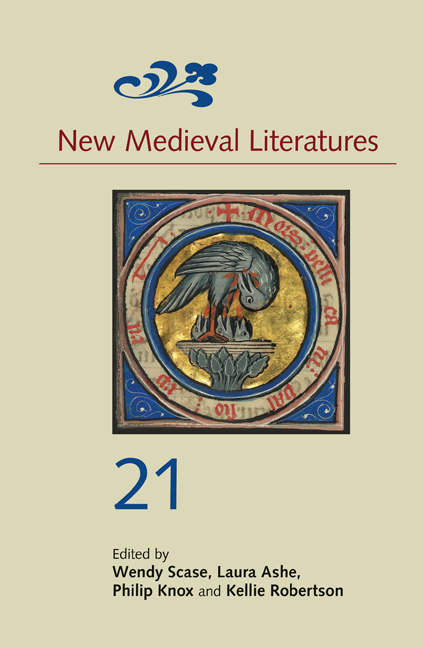Book contents
- Frontmatter
- Contents
- List of Illustrations
- List of Abbreviations
- 1 ‘Chevaliers estre deüsiez’: Genealogy and Historical Sense in Chrétien de Troyes’s Conte du Graal
- 2 English Vernacular Script in the Thirteenth Century (c.1175–c.1325)
- 3 The Manuscript as Agent: The Politics of London, British Library, Additional MS 15268 (Histoire ancienne jusqu’à César)
- 4 Repetition, Craft-Knowledge, and Richard Rolle’s Creaturely Sublime
- 5 Truth-Telling and Truthiness in the Middle English Popular Romances
- 6 Assaying the Deer Drive in Sir Gawain and the Green Knight
- 7 The Past of the Past: Historical Distance and the Medieval Image
7 - The Past of the Past: Historical Distance and the Medieval Image
Published online by Cambridge University Press: 13 April 2021
- Frontmatter
- Contents
- List of Illustrations
- List of Abbreviations
- 1 ‘Chevaliers estre deüsiez’: Genealogy and Historical Sense in Chrétien de Troyes’s Conte du Graal
- 2 English Vernacular Script in the Thirteenth Century (c.1175–c.1325)
- 3 The Manuscript as Agent: The Politics of London, British Library, Additional MS 15268 (Histoire ancienne jusqu’à César)
- 4 Repetition, Craft-Knowledge, and Richard Rolle’s Creaturely Sublime
- 5 Truth-Telling and Truthiness in the Middle English Popular Romances
- 6 Assaying the Deer Drive in Sir Gawain and the Green Knight
- 7 The Past of the Past: Historical Distance and the Medieval Image
Summary
This essay's subject is the role of visual culture in constructing both the medieval idea of antiquity and the modern idea of the Middle Ages. Historians of the early twentieth century saw the medieval image of antiquity as epoch-defining – ‘image’ in both conceptual and visual senses of the word, which in this discourse were fundamentally connected. Theirs was a profoundly influential argument, which still structures the conversation about medieval historical consciousness across many disciplinary fields of inquiry. Some very specific kinds of sources often lie at the heart of this argument: manuscripts of the fourteenth and fifteenth centuries (e.g., Figure 7.1). Returning to the medieval textual culture at the foundation of that argument makes it possible to reconsider, historicise, and critique controlling paradigms of twentieth-century intellectual history about the classical reception, periodisation, and the relationship between the two. But returning to the manuscripts also makes apparent this flawed argument's great insight: the significance of its key sources for understanding their creators’ historical thought and conceptions of temporality.
The first part of this essay re-examines the twentieth-century paradigm's foundational argument and some of the assumptions behind it – above all, the concept of ‘historical distance’. Part II then returns to the kinds of sources on which it is based, in a detailed contextual and visual analysis of one especially significant example: a group of three medieval manuscripts of Livy's Roman history (Figures 7.2–7.6). Livy's history was ultimately read everywhere in Europe, in its transmitted, translated, revised, re-translated, redacted, and derivative forms; this work of historical literature about and from antiquity therefore played a central role in the understanding of the ancient world among those with access to learned or recreational literacy. The three manuscripts on which this discussion concentrates are all copies of the same text: Pierre Bersuire's 1350s French translation of Ab urbe condita, in its revised version of c.1370. All three manuscripts were then produced at the same time and in the same place: Paris, c.1400. Finally, all three manuscripts are illuminated in the same style by a group of closely related artists, known as the ‘Boucicaut’ illuminators.
- Type
- Chapter
- Information
- New Medieval Literatures 21 , pp. 191 - 220Publisher: Boydell & BrewerPrint publication year: 2021



